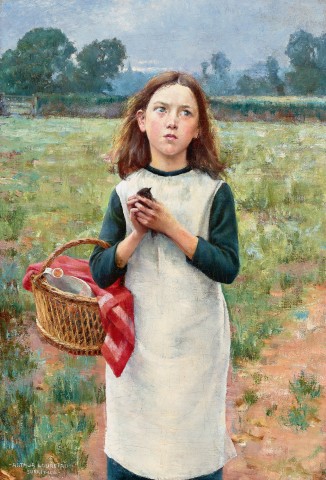YOUNG COMPANIONS, 1884
ARTHUR LOUREIRO
oil on canvas
76.0 x 51.0 cm
signed, dated and inscribed lower left: ''ARTHUR LOUREIRO'' / SURREY 1884
C.R. Staples, Melbourne
Private collection, Melbourne
Deutscher Fine Art, Melbourne
Private collection, Melbourne
Christie’s, Melbourne, 29 April 1997, lot 41
Joseph Brown Gallery, Melbourne
Private collection, Melbourne
Thence by descent
Private collection, Melbourne
Australian Art, Colonial to Modern, Deutscher Fine Art, Melbourne, 30 October – 18 November 1985, cat.43 (illus. in exhibition catalogue)
Table Talk, Melbourne, 19 October 1888, p.4
The solitary figure within the landscape had many manifestations in nineteenth-century painting. In Europe, they were often devoted to sentimental moments. In Australia, young women in bush settings provided popular subjects for painting outdoors, as in Tom Roberts’ A Summer Morning Tiff, 1886 (Art Gallery of Ballarat) and Frederick McCubbin’s Lost, 1886 (National Gallery of Victoria). Both are infused with engaging narratives of different kinds. Arthur Loureiro’s Young Companions, 1884 touches upon a favourite extension of the theme – of people and their relationship with animals.
As a leading teacher of plein air painting in Melbourne, Loureiro’s close friendship with McCubbin resulted in a rich exchange of influences. And as Jane Clark observed, Loureiro: ‘was said to have introduced the vogue for pastel portraiture in Australia which was taken up enthusiastically by Tom Roberts amongst others.’1
Born in Porto, Portugal, Loureiro’s studies included Rome, and from 1879, Paris at the École des Beaux-Arts under Alexandre Cabanel, who earlier included Jules Bastien-Lepage among his students. Exhibiting in the Paris Salons of 1880 to1882, his Australian connection came through his wife Marie Thérèse Huybens, of Hobart. Married in 1881, they lived at Brolles in the forest of Fontainebleau, chosen place of the French Barbizon School of painters, Corot, Diaz, Millet and Rousseau. Moving to London, Loureiro continued working as a plein air naturalist, as shown in the atmospheric freshness of Young Companions. Late that year they moved to Australia, seeking, for health reasons, a warmer climate. In Melbourne Loureiro soon rose to prominence. Along with Roberts and McCubbin, he was a foundation and council member of the progressive Australian Artists’ Association. Loureiro was also conspicuous in the Centennial International Exhibition of 1888 and later in the newly formed Victorian Artists’ Society. With a special gift for portraiture, his portrait of James Cooper Stewart, 1887, Mayor of Melbourne (1885-6), (Town Hall Collection, Melbourne), was heralded by the Bulletin as ‘one of the best portraits ever painted in Australia’.2 His self-portrait is in the Uffizi, Florence.
Loureiro had a special feeling for young people, a particularly engaging example being the pastel portrait of his son Vasco, Boy with an Apple, 1891 (National Gallery of Victoria). Another, the oil painting Two Friends, 1887, shows Vasco in a touching moment with his dog. Illustrated, at £80 it was the top priced work in the Australian Artists’ Association Winter Exhibition of 1887.3
In a lengthy article on Loureiro in Melbourne’s Table Talk, we learn that the noted Melbourne collector, Charles Raymond Staples bought Loureiro’s paintings: ‘ “The Forest at Fontainebleau”, and a picture of a little village girl holding a bird, both of which were painted previous to the artist’s arrival in Melbourne’.4 Loureiro’s inscription indicates that it was painted in Surrey, England, a country long given to close attachment to animals, pets and occasional pathos, as exemplified by Sir Edwin Landseer’s The Old Shepherd’s Chief Mourner, 1837 (Victoria and Albert Museum, London). With feelings of sweet sorrow, might not the young girl holding the bird be about to let it fly free?
1. Clark, J., ‘Arthur José de Souza Loureiro 1853-1932’, Art and Australia, Sydney, vol. 23, no.1, Spring 1985, p. 95
2.Bulletin, 19 March 1887, quoted in Mellor, S., ‘Loureiro, Artur Jose (1853-1932)’, Australian Dictionary of Biography, Melbourne University Press, Melbourne, vol. 5, 1974
3. Two Friends, 1887, Australian Artists’ Association, Winter Exhibition, 1887, cat. 14, (illus.) also formerly in the collection of C.R. Staples
4. Table Talk, Melbourne, 19 October 1888, p. 3
DAVID THOMAS
